Fresh Water Supply - The Greatest Climate Change Issue
Politics / Water Sector Mar 28, 2016 - 11:10 AM GMTBy: Richard_Mills
 Serbian astrophysicist Milutin Milankovitch is best known for developing one of the most significant theories relating to Earths motions and long term climate change.
Serbian astrophysicist Milutin Milankovitch is best known for developing one of the most significant theories relating to Earths motions and long term climate change.
Milankovitch developed a mathematical theory of climate change based on the seasonal and latitudinal variations in the solar radiation received by the Earth from our Sun - it was the first truly plausible theory for how minor shifts of sunlight could make the entire planet's temperature swing back and forth from cold to warm.
Milankovitch's Theory states that as the Earth travels through space around the sun, cyclical variations in three elements of Earth/sun/geometry combine to produce variations in the amount of solar energy that reaches us. These three elements are:
-
Variations in the Earth's orbital eccentricity - the shape of the orbit around the sun, a 100,000 year cycle
-
Changes in obliquity or tilt of the earth's axis - changes in the angle that Earth's axis makes with the plane of Earth's orbit, a 41,000 year cycle
-
Precession - the change in the direction of the Earth's axis of rotation, a 19,000 to 23,000 year cycle
These orbital processes are thought to be the most significant drivers of ice ages and, when combined, are known as Milankovitch Cycles.
Other Climate Change Drivers:
-
Changes occurring within the sun affects the intensity of sunlight that reaches the Earth's surface. These changes in intensity can cause either warming - stronger solar intensity - or cooling when solar intensity is weaker.
-
Volcanoes often affect our climate by emitting aerosols and carbon dioxide into the atmosphere. Aerosols block sunlight and contribute to short term cooling, but do not stay in the atmosphere long enough to produce long term change. Carbon dioxide (CO2) has a warming effect. For about two-thirds of the last 400 million years, geologic evidence suggests CO2 levels and temperatures were considerably higher than present. Each year 186 billion tons of carbon from CO2 enters the earth's atmosphere - six billion tons are from human activity, approximately 90 billion tons come from biologic activity in earth's oceansand another 90 billion tons from such sources as volcanoes and decaying land plants
These climate change "drivers" often trigger additional changes or "feedbacks" within the climate system that can amplify or dampen the climate's initial response to them:
-
The heating or cooling of the Earth's surface can cause changes in greenhouse gas concentrations - when global temperatures become warmer, CO2 is released from the oceans and when temperatures become cooler, CO2 enters the ocean and contributes to additional cooling. During at least the last 650,000 years, CO2 levels have tracked the glacial cycles - during warm interglacial periods, CO2 levels have been high and during cool glacial periods, CO2 levels have been low
-
The heating or cooling of the Earth's surface can cause changes in ocean currents. Ocean currents play a significant role in distributing heat around the Earth so changes in these currents can bring about significant changes in climate from region to region
In 1985 the Russian Vostok Antarctic drill team pulled up cores of ice that stretched through a complete glacial cycle. During the cold period of the cycle CO2 levels were much lower than during the warm periods before and after. When plotted on a chart the curves of CO2 levels and temperature tracked one another very closely - methane, an even more potent greenhouse gas, showed a similar rise and fall to that of CO2.
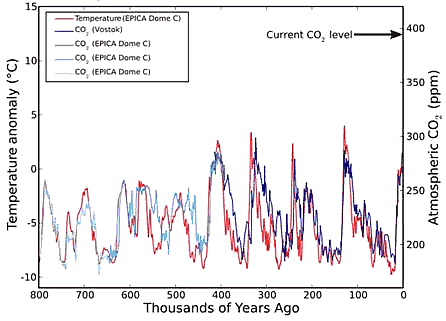
Small rises or falls in temperature - more, or less sunlight - seemed to cause a rise, or fall, in gas levels. Changing atmospheric CO2 and methane levels physically linked the Northern and Southern hemispheres, warming or cooling the planet as a whole. In the 1980s the consensus was that Milankovitch's Cycles would bring a steady cooling over the next few thousand years.
As studies of past ice ages continued and climate models were improved worries about a near term re-entry into the cold locker died away - the models now said the next ice age would not come within the next ten thousand years. In other words temperatures are going to continue to rise.
It's obvious that the orbital changes, as explained by Milankovitch's Theory, initiate a powerful feedback loop. The close of a glacial era comes when a shift in sunlight causes a slight rise in temperature - this raises gas levels over the next few hundred years and the resultant greenhouse effect drives the planet's temperature higher, which drives a further rise in the gas and water vapor levels and so on.
The earth will continue to warm, polar ice caps will melt, so will the Greenland ice sheet and most glaciers. More sunlight will be absorbed by the Earth's oceans, causing increased evaporation. Water vapor is a greenhouse gas and amplifies twofold the effects of other greenhouse gases.
With Earth's ice gone there will be significantly less sunlight reflected back into space, vast expanses of Arctic tundra will thaw releasing unbelievable amounts of methane, a greenhouse gas twenty times more potent then CO2.
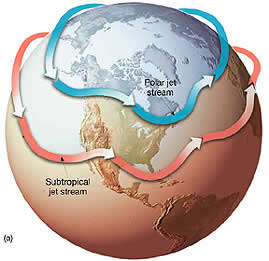
By the end of this century scientists expect our weather to have changed substantially. One of the changes being the subtropical dry zones will push pole-ward, crawling deep into regions such as the American Southwest and southern Australia, which will be increasingly susceptible to prolonged and intense droughts.
The polar jet stream has already been altered, wide swinging north-south deviations (meanders) have become the norm. Deviating far from its normal path and meandering north into Canada the jet stream brings warm air. While dipping far south over Europe the polar jet stream brings record cold and snow.
Ocean currents will be altered, further impacting our climate, and sea levels will rise. Freshwater aquifers will suffer from saltwater intrusion, once habitable zones will become uninhabitable,
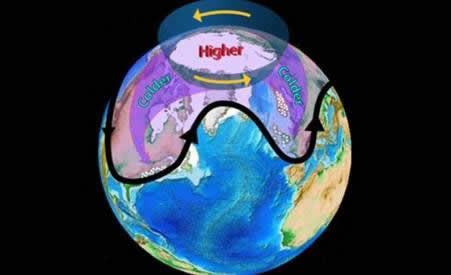
As the meanders meander extreme weather follows
According to science the world is going to continue to get warmer, cyclical variations in three elements of earth/sun/geometry have combined to produce more sunlight reaching the earth. Increased sunlight caused a slight rise in temperature - greenhouse gas levels rose and the resultant greenhouse effect is driving the planet's temperature higher, which drives a further rise in gas levels and so on.
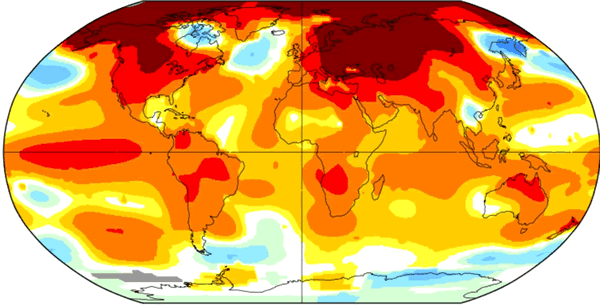
"Humanity's experiment with planetary warming has reached a new level of extremes. Last month was the hottest February in 137 years of record keeping, according to data released Thursday by the National Oceanic and Atmospheric Administration. It's the 10th consecutive month to set a new record, and it puts 2016 on course to set a third straight annual record.
It was a big month, not only the hottest February but the most unusual warmth for any month on record. Unprecedented temperatures in the Arctic, averaging an astonishing 20 degrees Fahrenheit above normal, melted away layers of ice to record-low levels. The heat helped prolong the longest planet-wide coral bleaching event. These grim milestones coincide with the biggest recorded jump in carbon dioxide, the most important greenhouse gas.
To be sure, some of this is the result of a monster El Niño weather pattern lingering in the Pacific Ocean. But the broader trend is clear: We live on a planet that is warming rapidly, with no end in sight. Since 1980, the world has set a new annual temperature record roughly every three years, and 15 of the hottest 16 years ever measured are in the 21st century.
The El Niño that started last year produced some of the hottest temperatures ever witnessed across great swaths of the equatorial Pacific. By some measures, this may now be the most extreme El Niño on record. It has triggered powerful typhoons, spoiled harvests in Africa, and contributed to vast fires in Indonesia. In California, El Niño precipitation is replenishing the snowpack and beginning to refill drought-ravished reservoirs.
Results from the world's top monitoring agencies vary slightly, but NASA, NOAA, and the Japan Meteorological Agency all agree that February was unprecedented. Its heat was experienced differently around the world, though few regions escaped it entirely. The map above, from NASA, shows a few blue spots of cooler-than-average temperatures and plenty of record-breaking red. The most extreme heat swept the Arctic, where ice levels were at the lowest on record for this time of year." ~ Tom Randell, Bloomberg 'Stunning Global Heat Wave Pushes Planet Into Uncharted Territory'
A quiet disaster
Drought is a normal recurring feature of the climate in most parts of the world. It doesn't get the attention of a tornado, hurricane or flood. It's slower and less obvious, a much quieter disaster creeping up on us unawares.
Climate change is currently causing abnormal warming of many regions, warmer temperatures increase the frequency and intensity of heat waves and droughts.
We can prepare for some climate change consequences with public education, water conservation programs, limiting pumping from our freshwater aquifers to recharge rates and putting in place early warning systems for extreme heat events.
The collapse of the world's earliest known empire was because of drought.
Akkad
The Akkadians of Mesopotamia forged the world's first empire more than 4,300 years ago. The Akkad's seized control of cities along the Euphrates River and swept up onto the plains to the north - in a short period of time their empire stretched 800 miles, all the way from the Persian Gulf to the headwaters of the Euphrates, through what is now Iraq, Syria and parts of southern Turkey.
Tell Leilan was a small village founded by some of the world's first farmers. It's located in present day Syria and has existed for over 8,000 years. The Akkad's conquered Tell Leilan around 2300 B.C. and the area became the breadbasket for the Akkadian empire.
After only a hundred years the Akkadian empire started to collapse.
In 1978, Harvey Weiss, a Yale archaeologist, began excavating the city of Tell Leilan. Everywhere Weiss dug he encountered a layer of dirt that contained no signs of human habitation. This dirt layer corresponded to the years 2200 to 1900 B.C. - the time of Akkad's fall.
The Curse of Akkad
For the first time since cities were built and founded,
The great agricultural tracts produced no grain,
The inundated tracts produced no fish,
The irrigated orchards produced neither wine nor syrup,
The gathered clouds did not rain, the masgurum did not grow.
At that time, one shekel's worth of oil was only one-half quart,
One shekel's worth of grain was only one-half quart....
These sold at such prices in the markets of all the cities!
He who slept on the roof, died on the roof,
He who slept in the house, had no burial,
People were flailing at themselves from hunger.
The events described in "The Curse of Akkad" were always thought to be fictional. But the evidence Weiss uncovered at Tell Leilan (along with elevated dust deposits in sea-cores collected off Oman) suggest that localized climate change - in Tell Leilan's case a three hundred year drought - desertification - was the major cause.
"Since this is probably the first abrupt climate change in recorded history that caused major social upheaval. It raises some interesting questions about how volatile climate conditions can be and how well civilizations can adapt to abrupt crop failures." ~ Dr. Harvey Weiss, Yale University archeologist
Ghost Empire
Perhaps the most notable empire decline due to drought, or altered precipitation patterns, was the Maya empire. At the peak of their glory the Maya ranged from Mexico's Yucatán peninsula to Honduras. Some 60 Maya cities - each home to upwards of 70,000 people - sprang up across much of modern day Guatemala, Belize, and Mexico's Yucatán Peninsula.
"The early Classic Maya period was unusually wet, wetter than the previous thousand years...Mayan systems were founded on those [high] rainfall patterns. They could not support themselves when patterns changed." ~ Douglas Kennett, an environmental anthropologist at Pennsylvania State University.
During the wettest centuries, from 440 to 660, Maya civilization flourished.
Then things got worse, much worse. The following centuries, from the mid 600's to roughly 1000 A.D., did not treat the Mayas kindly, they suffered repeatedly from drought, oftentimes extreme drought lasting a decade and more.
Between 1020 and 1100 the region suffered the longest dry spell in many millennia. The Maya's suffered crop failure after failure, famine, death and eventually mass migration.
"Yucatecan lake sediment cores ... provide unambiguous evidence for a severe 200-year drought from AD 800 to 1000 ... the most severe in the last 7,000 years ... precisely at the time of the Maya Collapse." ~ Richardson Gill, The Great Maya Droughts
After 200 years of drought, really just an eye-blink of time, famine and drought held sway and people walked away leaving behind a ghost empire.
North American Drought
"Once upon a time, much of the state of California was a barren desert. And now, thanks to the worst drought in modern American history, much of the state is turning back into one. Scientists tell us that the 20th century was the wettest century that the state of California had seen in 1000 years. But now weather patterns are reverting back to historical norms..." ~ Michael Synder, The Economic Collapse
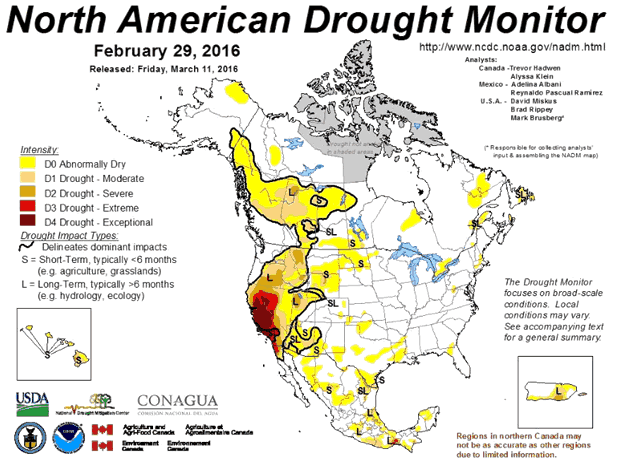
The above drought picture is very scary considering it is a snapshot of what should be the wettest part of the year in many areas.
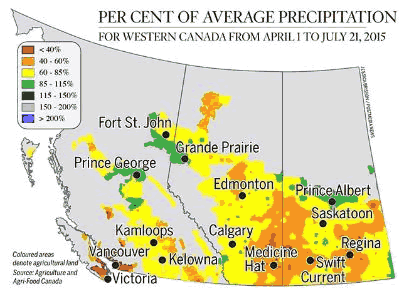
Water is a commodity whose scarcity will have a profound effect on the world within the next decade - the danger to us from the worsening ecological overshoot concerning the world's fresh water supply makes the reevaluation of our values mandatory. We will have to drastically change the way in which we view our freshwater as a resource.
The central issues for us over the next few decades are climate change and the usage of our fresh water resources.
Water, An Endangered Global Resource
Our groundwater is being used up at record rates and claims to ownership are becoming increasingly contentious. It won't be long before the first water war begins.
There's a lot of water on the planet we inhabit - an estimated 326 million trillion gallons or 1,260,000,000,000,000,000,000 liters.
That makes it hard to believe that there are somewhere between 780 million to one billion people without basic and reliable water supplies and that more than two billion people lack the requirements for basic sanitation.
Harder still to believe are reports water is going to get much dearer in our near term future - yet Peter Voser the chief executive of the world's second-largest energy company, Royal Dutch Shell, warned us in June 2011, that global demand for fresh water may outstrip supply by as much as 40 per cent in 20 years if current fresh-water consumption trends continue.
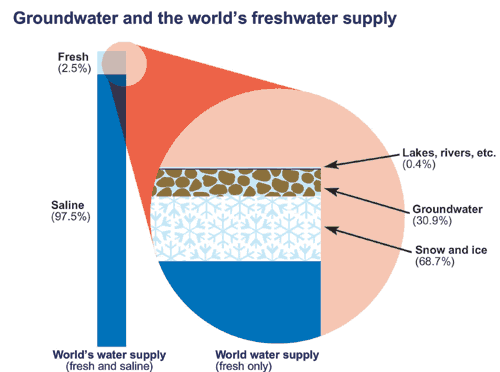
Our planet is 70 percent covered in ocean, ninety-eight percent of the world's water is in the oceans - which makes it unfit for drinking or irrigation because of salt.
Just two percent of the world's water is fresh, but the vast majority of our fresh water, 1.6 percent, is in its frozen state and locked up in the polar ice caps and glaciers. Once it melts it contaminated by seawater, either by melting directly into the oceans or running to the world's oceans through a stream or river.
Our available freshwater (.396 percent of total supply) is found underground in aquifers and wells (0.36 percent) and the rest of our readily available fresh water, 0.036 percent, is found in lakes and rivers.
Aquifers
Freshwater aquifers are one of the most important natural resources in the world today, but in recent decades the rate at which we're pumping them dry has more than doubled. The amount of water pumped has gone from 126 to 283 cubic kilometers per year - if water was pumped as rapidly from the Great Lakes they would be dry in roughly 80 years.
These fast shrinking underground reservoirs are essential to life on this planet. They sustain streams, wetlands, and ecosystems and they resist land subsidence and salt water intrusion into our fresh water supplies.
Many people think of aquifers as underground lakes but that's not the case - the water is held between rock particles. Water infiltrates into the soil through pores and cracks until it reaches what is called the zone of saturation - all of the spaces between the rocks are filled with water, not air.
This zone of saturation occurs because water infiltrating the soil reaches an impermeable layer of rocks it can't soak through.

Water held in aquifers is known as groundwater. The water table is located at the top of the zone of saturation. Groundwater represents about 30 percent of the available fresh water on the planet - surface water accounts for less than one percent. The rest is locked up in glaciers or the polar ice caps.
Almost all of the planet's liquid fresh water is stored in aquifers. Some of the largest cities in the developing world - Jakarta, Dhaka, Lima, and Mexico City - depend on aquifers for almost all their water.
Most rural areas pump groundwater from wells drilled into an aquifer.
There are two types of aquifers: replenishable (a permeable layer of rock above the water table and an impermeable one beneath it) and non-replenishable (also known as fossil aquifers, no recharge) aquifers. Most of the aquifers in India and the shallow aquifer under the North China Plain are replenishable. When these are depleted, the maximum rate of pumping is automatically reduced to the rate of recharge or refill.
For fossil aquifers - such as the vast U.S. Ogallala aquifer, the deep aquifer under the North China Plain, or the Saudi aquifer - depletion brings pumping to an end.
Depletion Effects
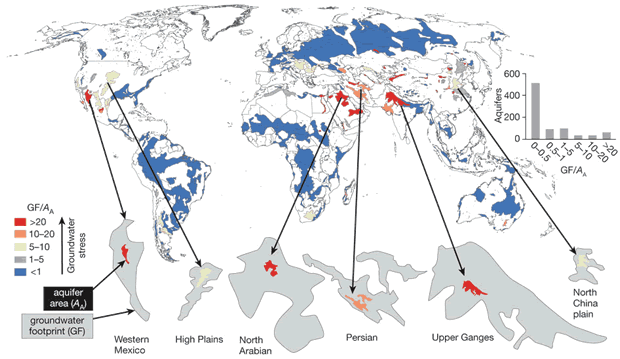
The red area on the above map is the aquifer, the grey area is the size of the area that would be required to catch enough rainfall to replenish that aquifer and make up for all the water currently being pumped out of it.
When groundwater is depleted the effects (besides lessening of supply or no more water) can be drastic. Land subsidence happens when porous formations that once held water collapse resulting in the surface layer settling. Water won't compress, but when the water is sucked out of an aquifer air fills the void between the rocks where the water use to be. Air compresses and the ground sinks or compacts - the aquifer will never hold the same amount of water again.
One study shows that from 1986 to 1992 some parts of the Mexico City Aquifer's water levels dropped 6 to 10 meters. Areas of Mexico City, as a consequence, have fallen as much as 8.5 meters. The subsidence (ground compaction) is also damaging the sewer system, potentially leading to untreated sewage mixing with fresh water in the aquifer.
In March of 2009, Enoch City in Iron County, Cedar Valley Utah, contacted the Utah Geological Survey (UGS) about what they believed to be a fault running through one of their new subdivisions. It was determined by the UGS that it was a fissure caused by the groundwater level dropping as much as 114 feet since 1939 - the cause was determined to be due to pumping more groundwater than is recharged (refilled).
Another effect of over pumping is saltwater intrusion. If too much groundwater is pumped out from coastal aquifers saltwater may flow into them causing contamination of the aquifer. Many coastal aquifers - the Biscayne Aquifer near Miami and the New Jersey Coastal Plain aquifer for example - have problems with saltwater intrusion.
Streams, rivers and lakes are almost always closely connected with an aquifer. The depletion of aquifers doesn't allow these surface waters to be recharged - lowering water levels in aquifers is being reflected in reduced amounts of water flowing at the surface.
This is happening along the Atlantic Coastal Plain, groundwater depletion is also responsible for the Yellow River in China not reaching the ocean for months at a time, the failure of the Colorado River in the U.S. and the Indus River in Pakistan failing to reach the ocean every day.
"If you let the population grow by extending the irrigated areas using groundwater that is not being recharged, then you will run into a wall at a certain point in time, and you will have hunger and social unrest to go with it. That is something that you can see coming for miles." ~ Marc Bierkens of Utrecht University in Utrecht, the Netherlands
There is widespread surface and groundwater contamination that makes valuable water supplies unfit for other uses.
Power Supply Will Be Impacted By Water Shortages
Electricity enables our modern life style - the degree of dependency we have built into our lives in regards to "power on demand" has raised expectations that plentiful electricity will be available to us 24/7.
"Electrical power, in the short span of two centuries, has become an indispensible part of modern day life. Our work, leisure, healthcare, economy, and livelihood depend on a constant supply of electrical power. Even a temporary stoppage of power can lead to relative chaos, monetary setbacks, and possible loss of life. Our cities live on electricity and without the customary supply from the power grid, pandemonium would break loose." ~ Dieselserviceandsupply.com
Power plants are completely dependent on water for cooling, they are overheating and utilities are shutting them down or running their plants at lower capacity.
If the water levels in the rivers they use for cooling drop too low, the power plant - already overworked from the heat - won't be able to draw in enough water and if the cooling water discharged from the plant raises already high river water temperatures above safe environmental limits a plant will be forced to shut down.
The lack of rain, and the incessant heat, has also increased the need for irrigation water for farming, meaning increasing competition between the agricultural and power generation sectors for the same water.
'Burning Our Rivers: The Water Footprint of Electricity' by River Network reports...
"For every gallon of residential water used in an average household, five times more is used to provide that home with electricity via hydropower turbines and fossil fuel power plants (40,000 gallons each month).
Electricity production by coal, nuclear and natural gas power plants is the fastest-growing use of freshwater in the U.S., accounting for more than about ½ of all fresh, surface water withdrawals from rivers and lakes. This is more than any other economic sector, including agriculture."
The average nuclear plant requires 2725 liters of water per megawatt hour for cooling, coal 1890 liters of water and natural gas plants 719 liters per megawatt hour.
Conclusion
The greatest issue facing us in the 21st century is how we will use and share the planets less than half a per cent of usable freshwater.
Investment in water management as a percentage of GDP has dropped by half in most countries since the late 1990s.
Advances in technology, innovation, and best practices/conservation are already clashing with finite water resources, relentless population growth, changing diets, a lack of investment in water infrastructure and increased urban, agricultural and industrial water usage.
Climate change is causing the Earth to warm, precipitation is shifting from the mid-latitudes to the low and high latitudes - wet areas are becoming wetter and dry areas drier. Less rainfall in the mid-latitudes means less new water to refill the aquifers that are being depleted the fastest.
Are more frequent droughts, long heat waves and an increasing population going to continue to strain power generation in the future?
Water is a commodity whose scarcity will have a profound effect on the world within the next decade - water scarcity makes the reevaluation of our values mandatory. We will have to drastically change the way in which we view our freshwater as a resource.
Are our fresh water resources on your radar screen?
If not, maybe they should be.
By Richard (Rick) Mills
If you're interested in learning more about the junior resource and bio-med sectors please come and visit us at www.aheadoftheherd.com
Site membership is free. No credit card or personal information is asked for.
Richard is host of Aheadoftheherd.com and invests in the junior resource sector.
His articles have been published on over 400 websites, including: Wall Street Journal, Market Oracle, USAToday, National Post, Stockhouse, Lewrockwell, Pinnacledigest, Uranium Miner, Beforeitsnews, SeekingAlpha, MontrealGazette, Casey Research, 24hgold, Vancouver Sun, CBSnews, SilverBearCafe, Infomine, Huffington Post, Mineweb, 321Gold, Kitco, Gold-Eagle, The Gold/Energy Reports, Calgary Herald, Resource Investor, Mining.com, Forbes, FNArena, Uraniumseek, Financial Sense, Goldseek, Dallasnews, Vantagewire, Resourceclips and the Association of Mining Analysts.
Copyright © 2016 Richard (Rick) Mills - All Rights Reserved
Legal Notice / Disclaimer: This document is not and should not be construed as an offer to sell or the solicitation of an offer to purchase or subscribe for any investment. Richard Mills has based this document on information obtained from sources he believes to be reliable but which has not been independently verified; Richard Mills makes no guarantee, representation or warranty and accepts no responsibility or liability as to its accuracy or completeness. Expressions of opinion are those of Richard Mills only and are subject to change without notice. Richard Mills assumes no warranty, liability or guarantee for the current relevance, correctness or completeness of any information provided within this Report and will not be held liable for the consequence of reliance upon any opinion or statement contained herein or any omission. Furthermore, I, Richard Mills, assume no liability for any direct or indirect loss or damage or, in particular, for lost profit, which you may incur as a result of the use and existence of the information provided within this Report.
Richard (Rick) Mills Archive |
© 2005-2022 http://www.MarketOracle.co.uk - The Market Oracle is a FREE Daily Financial Markets Analysis & Forecasting online publication.



